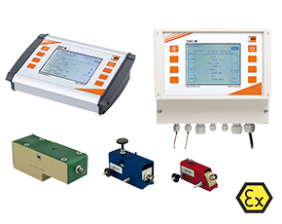KOBOLD Instruments Inc • 1801 Parkway View Drive • 15205 Pittsburgh, PA • Tel: +1 412 788 2830 • E-mail: Please activate JavaScript • visit koboldusa.com

Ultrasonic Flow Meter - Clamp-on - DUC
For liquids
Stationary ·
Flow velocities: 0 ... ±30 m/s
Measuring units: volume flow, flow velocity, thermal output
Connection: clamp-on for pipe sizes DN10 ... DN6000
tmax: 150°C
Accuracy: up to 1 %
Output: 2x 4 - 20 mA, pulse, micro-USB, relay, RS232, RS485, totalizer

Datasheet
Operating Instructions
Miscellaneous
Approvals
Description
DUC uses the effect of acceleration and decelaration of acoustic signals travelling in a moving liquid. Two ultrasonic clamp-on transducers are mounted (from outside) on a pipe and produce an acoustic path. The transducers send and receive acoustic signals and the transit times t1 and t2 are measured by an electronic flow transmitter.
The signal from transducer A towards transducer B is accelerated by the flow (short t1). The return signal from transducer B to transducer A is decelerated by the flow (longer t2). The difference between t1 and t2 together with the path length L can be used to determine the average flow velocity. This principle is known as the acoustic time-of-flight principle. The flow is calculated from the geometry data of the pipe and the flow velocity.
DUC emits a coded signal pattern into the pipe. The received signals will be compared with the sent signals and only the signal pattern which correlates with the original one will be used for flow calculation (cross correlation based signal evaluation). The calculation of the flow is done with the integrated DSP (digital signal processor). Thus the calculation has high sampling rates. The DSP calculation of the time-of-flight is a pure digital transit time measurement, it works very precise, is completely drift and maintenance free and there is no need for recurring calibrations.





